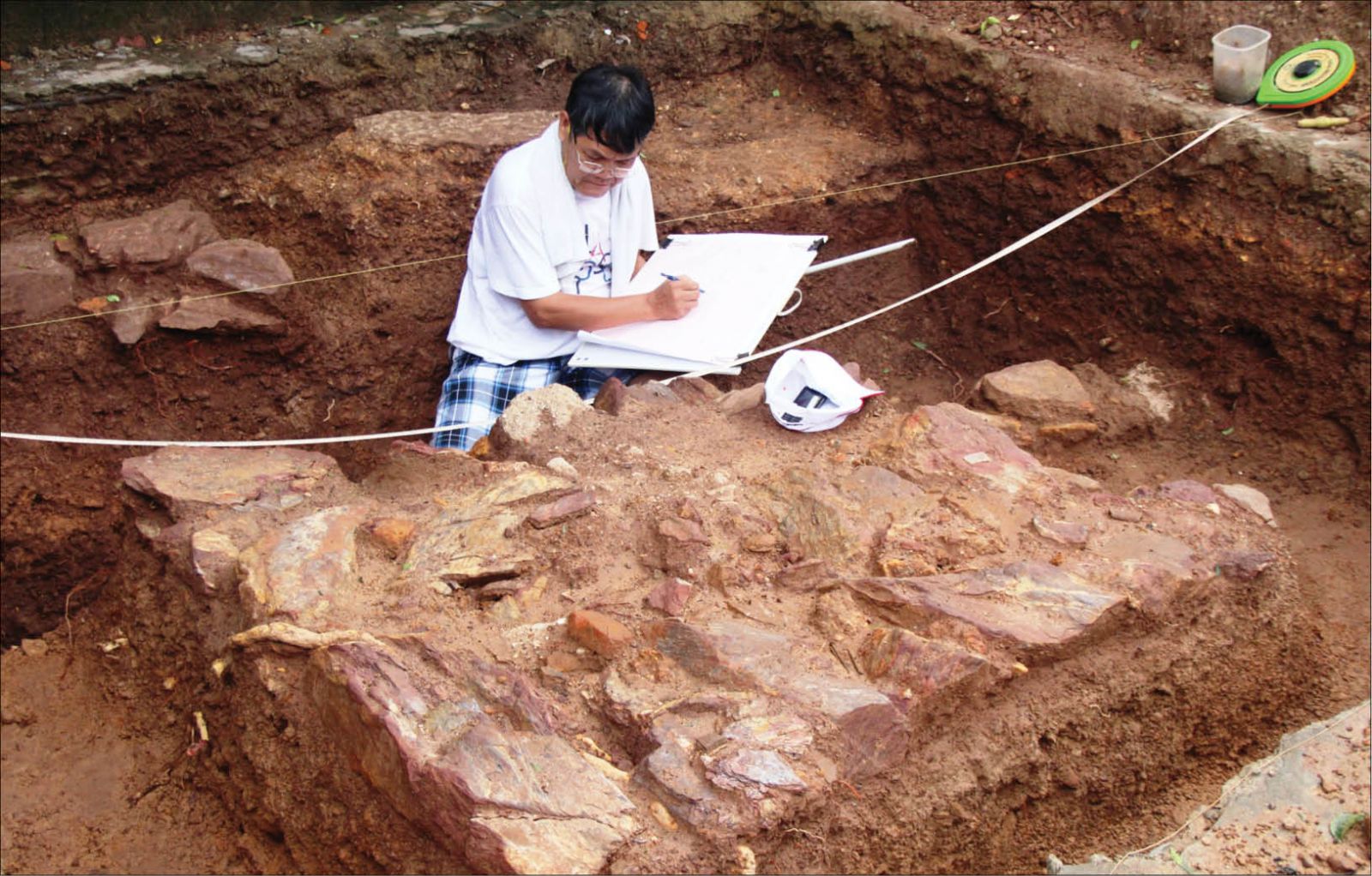
The fifth excavation pit, where a large stone structure was discovered during the excavation at the end of 2016, will be expanded for further archeological investigations.
Many significant findings
During the excavation at the end of 2016, experts from Vietnam Institute of Archeology (VIA) in collaboration with experts from Thua Thien Hue Museum of History, and Department of History of Hue University College of Sciences had dug five excavation pits with a total area of nearly 24 sq.m. at Duong Xuan mound, near Thuyen Lam and Van Phuoc Pagodas (which, according to researcher Nguyen Dac Xuan, was the location of Emperor Quang Trung’s imperial palace- Dan Duong Palace and his burial site). From these 5 pits, many relics, archaeological artifacts and architectural structures have been discovered. Among them, there are three relics related to remains of cremation graves, a broken terracotta urn used as a coffin presumably belonged to a soil grave, and remains of a base made of gravel and sand believed to be the foundation of a structure or a stone pillar base. Also, hundreds of archeological artifacts were collected at the excavation site such as pieces of bronze, iron, porcelain, terracotta, tile, glass, lime, bones, shell, and ceramic artifacts were the biggest collection of all (up to 337 pieces).
The most significant finding of all is a stone structure of more than 5.5 meters wide, and from 0.6 to 0.65 meter thick. The stones were stacked atop one another in layers forming two corners. This structure may have been part of a larger building, say, the foundation of a wall.
According to VIA Vice President Assoc. Prof. Dr. Bui Van Liem, who oversees the opening of exploratory pits, what have been found are significant findings, and yet the matter of dating and owners of those relics and artifacts has been unidentified. Therefore, expansion of the excavation is highly recommended.

A stone structure discovered at Duong Xuan Mound during the excavation at the end of 2016
Consultation with local authorities on extensive excavation
According to VIA’s planning report, before the next archaeological investigation, archaeologists suggested to Thua Thien Hue People's Committee conducting site clearance including the relocation of residential areas, and some underground construction such as electrical and water conduits at Binh An residential area (Truong An Ward) with an area of around 300 sq.m. Site clearance, and compensation for households located in the expected excavation area is scheduled to be done from now until the end of the first quarter of 2018.
Of all the 300 sq.m. estimated excavation area, 200 sq.m. is for the fifth excavation pit (H5-2016) - the main archeological site where the stone wall was discovered in October 2016. From the location of H5-2016 to the direction of Thien Lam Pagoda, the excavation will be expanded with a distance of 50m. Besides, four more areas will be added to the list of excavation sites including Bong Su (25 sq.m.), an old water well (25 sq.m.), the graveyard in front of Van Phuoc Pagoda (25sq.m.) and a semicircle lake (25 sq.m.). These excavations will be conducted in the second quarter of 2018, for about 90 days.VIA Vice President Assoc. Prof. Dr. Bui Van Liem will continue to take charge of the excavation expansion.
According to Mr. Phan Tien Dung, Director of the provincial Department of Culture, Sports and Tourism, the expansion of Duong Xuan mound excavation in the coming time will be a complicated and difficult task that should be handled step by step. The provincial People's Committee has assigned the task to the Department in coordination with VIA to work out specific plans related to the excavation process.
The authorities should also give careful considerations to the relocation and compensation for households whose estates are affected. in the excavation expansion, which requires cooperation from Thua Thien Hue People's Committee and Truong An Ward executives. "At present, a master plan is being developed and will be submitted to the provincial People's Committee to work on relevant procedures and apply for an archaeology excavation permit from Ministry of Culture, Sports and Tourism," Mr. Dung said.
According to Mr. Dung, in line with the excavation expansion, they are planning to hold an exhibition of the artifacts found in the last excavation pit investigations to serve the public and tourism.
Story and photos: PHAN THANH